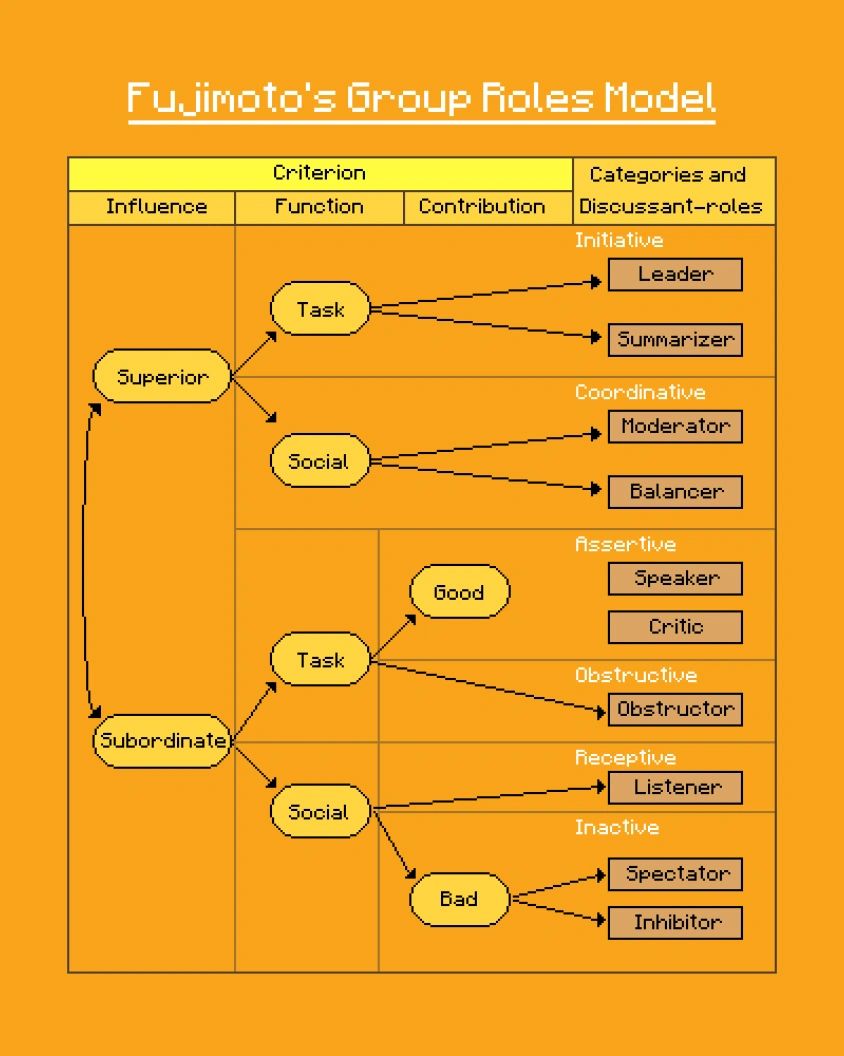Some roles are common amongst most groups and tend to emerge spontaneously. Separated by sociologists into either “task roles” or “social roles”, these “unformalized behavior patterns” and “situational identities”, develop over time and through sustained interactions in group settings, according to R.H. Turner in ‘Handbook Of Sociological Theory’. The idea Turner put forward on role theory is that a community cohesion is created by members properly acquiring and executing these various task and relationship roles so long as the “clustering of goals, activities, and sentiments” that form the roles also “maximize mutually reinforcing elements and minimize contradictory effects.”
The Functional Task Roles Of Group Members
Functional task roles in groups can be found below, adapted from ‘Functional Roles of Group Members’ by K. D. Benne and P. Sheats, Journal of Social Issues, 1948.
- Initiator/contributor: Recommends novel ideas about the problem at hand, new ways to approach the problem, or possible solutions not yet considered
- Information seeker: Emphasizes getting the facts by calling for background information from others
- Opinion seeker: Asks for more qualitative types of data, such as attitudes, values, and feelings
- Information giver: Provides data for forming decisions, including facts that derive from expertise
- Opinion giver: Provides opinions, values, and feelings
- Elaborator: Gives additional information, examples, rephrasings, implications about points made by others
- Coordinator: Shows the relevance of each idea and its relationship to the overall problem
- Orienter: Refocuses discussion on the topic whenever necessary
- Evaluator/critic: Appraises the quality of the group’s methods, logic, and results
- Energizer: Stimulates the group to continue working when discussion flags
- Procedural technician: Cares for operational details, such as materials, machinery, and so on
- Recorder: Takes notes and maintains records
The Functional Social Roles Of Group Members
Functional social roles in groups can be found below, adapted from ‘Functional Roles of Group Members’ by K. D. Benne and P. Sheats, Journal of Social Issues, 1948.
- Encourager: Rewards others through agreement, warmth, and praise
- Harmonizer: Mediates conflicts among group members
- Compromiser: Shifts his or her own position on an issue in order to reduce conflict in the group
- Gatekeeper/expediter: Smooths communication by setting up procedures and ensuring equal participation from members
- Standard setter: Expresses or calls for discussion of standards for evaluating the quality of the group process
- Group observer/commentator: Points out the positive and negative aspects of the group’s dynamics and calls for change if necessary
- Follower: Accepts the ideas offered by others and serves as an audience for the group
Can One Person Fulfill Both Functional Roles – Task & Social?
Yes, it is possible for one person to fulfill both task and relationship roles at the same time, but “Few people have the interpersonal and cognitive skills needed to enact both roles successfully,” according to Donelson Forsyth in ‘Group Dynamics’. P.J. Burke agrees with Forsyth in stating, “Because the task specialist is himself the principal source of tension it is unlikely that he would be effective in resolving this tension, and, if the tension is to be reduced, someone other than the task leader must assume a role aimed at the reduction of interpersonal hostilities and frustration.” – ‘The Development Of Task And Social-Emotional Role Differentiation’
Personality & Roles Are Linked In Practice
Referencing the above work of Benne and Sheats, Manabu Fujimoto states that there are theoretical problems in a two category role structure: “A simple structure of two categories based solely on function is insufficient for classifying the various team roles”, because, in actuality, “personality and roles are linked.” As it presents “unspecialized roles and behaviors”, Fujimoto continues, the Benne and Sheats “structure is one-dimensional” and “unable to categorize complex team roles adequately”, resulting in “overly fragmented roles as well as oversimplified categories.” – ‘Team Roles And Hierarchic System In Group Discussion’.
Fujimoto suggests a “three-criterion model based on the structure of deep roles“: Rather than task and social-oriented functional roles, his model’s criterion are influence, function, and contribution. Manabu Fujimoto’s Group Roles Structure, based on deep roles, is illustrated below.
Note that the “Superior” enacts both task and social behaviors as a function of role.

Thanks for reading!
